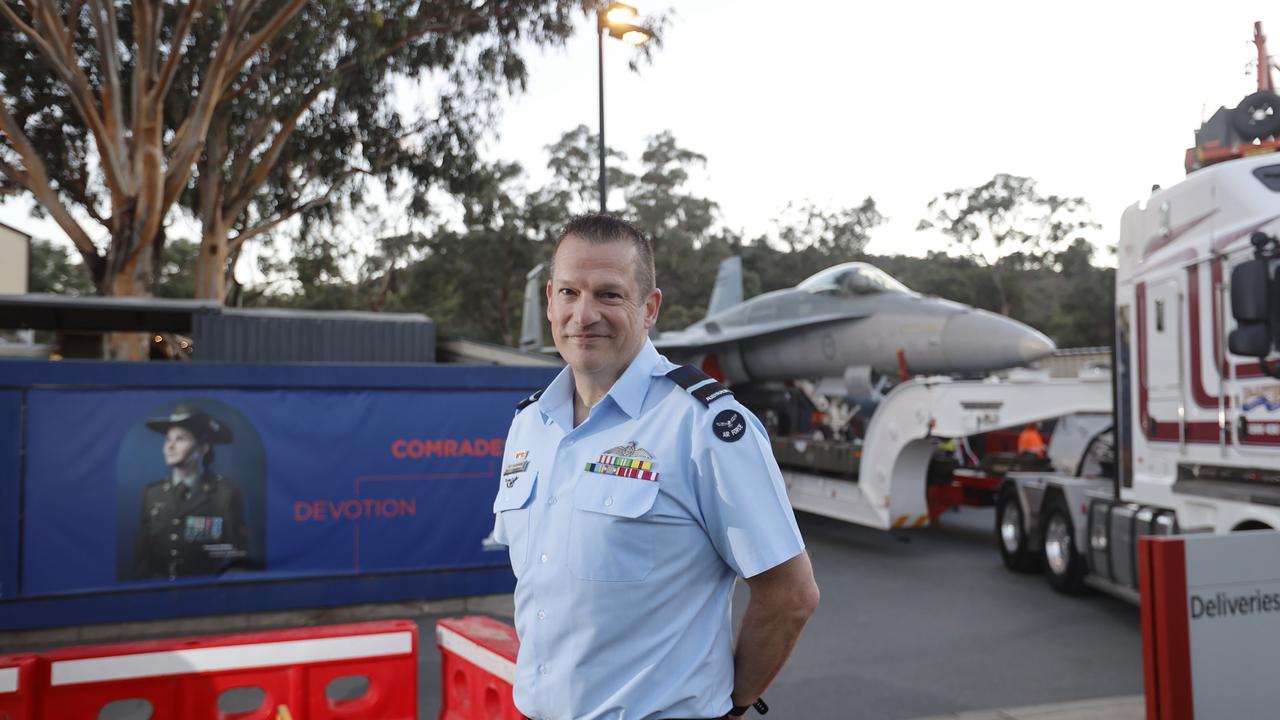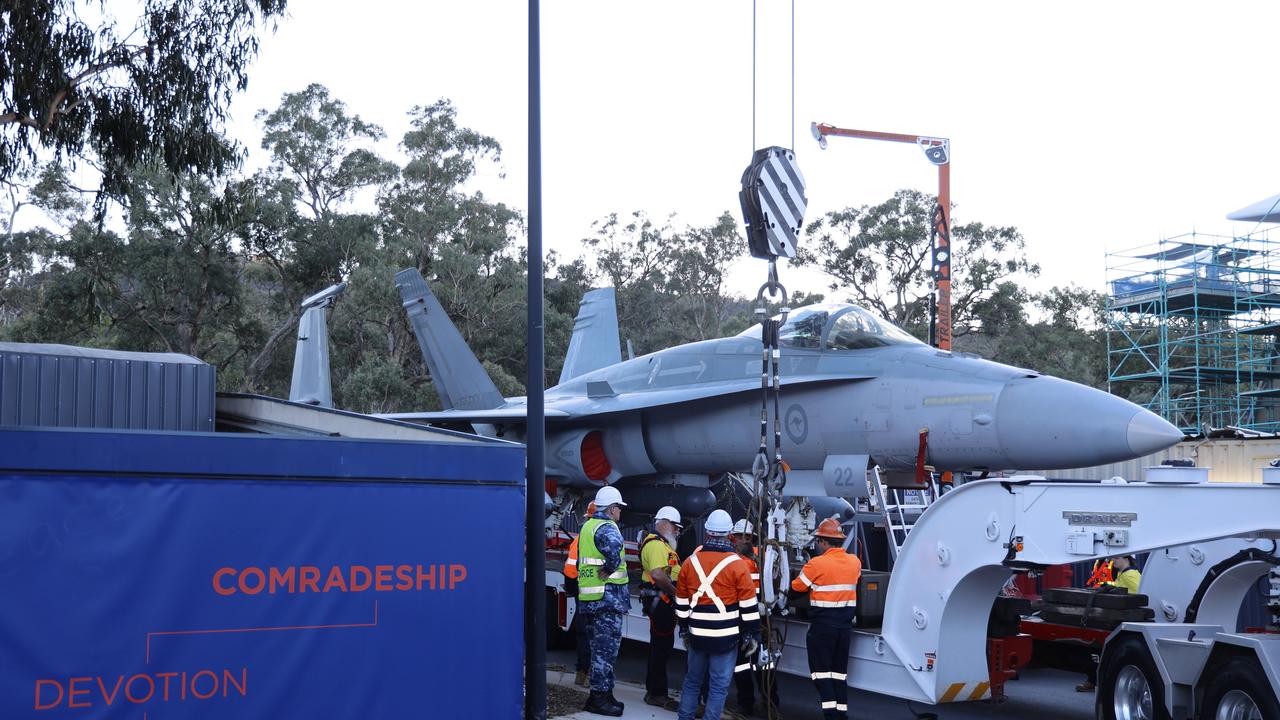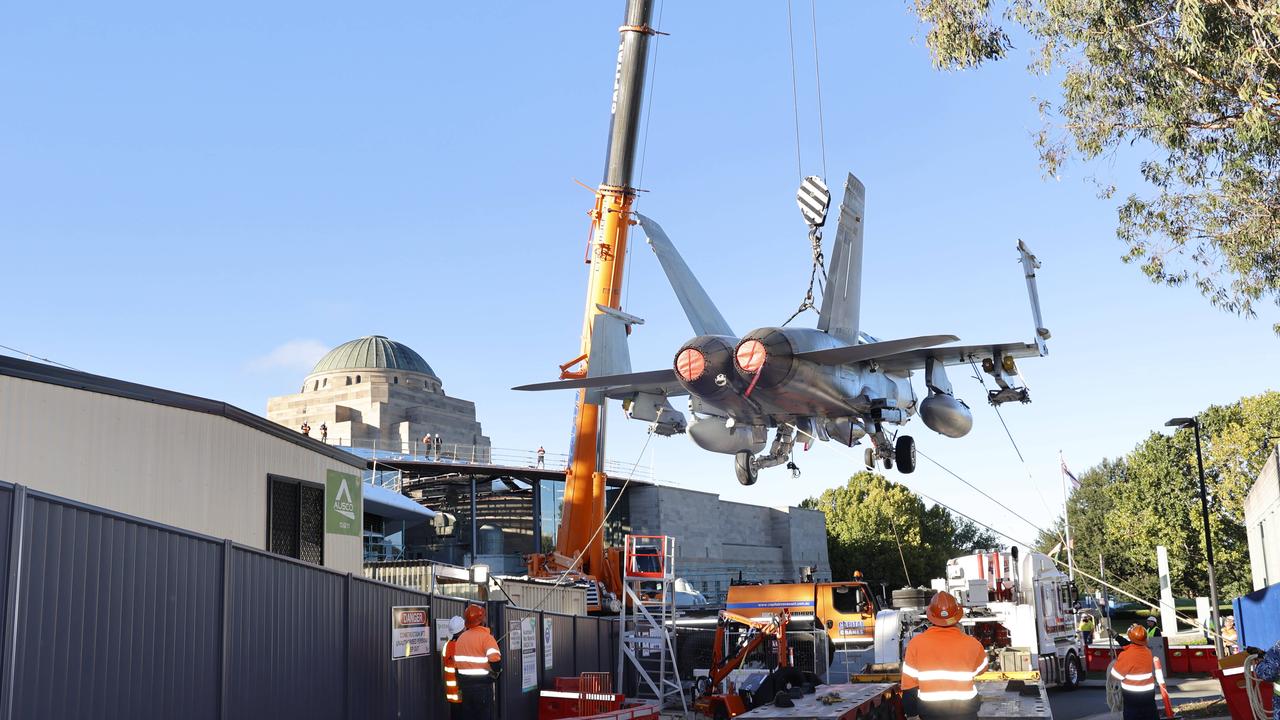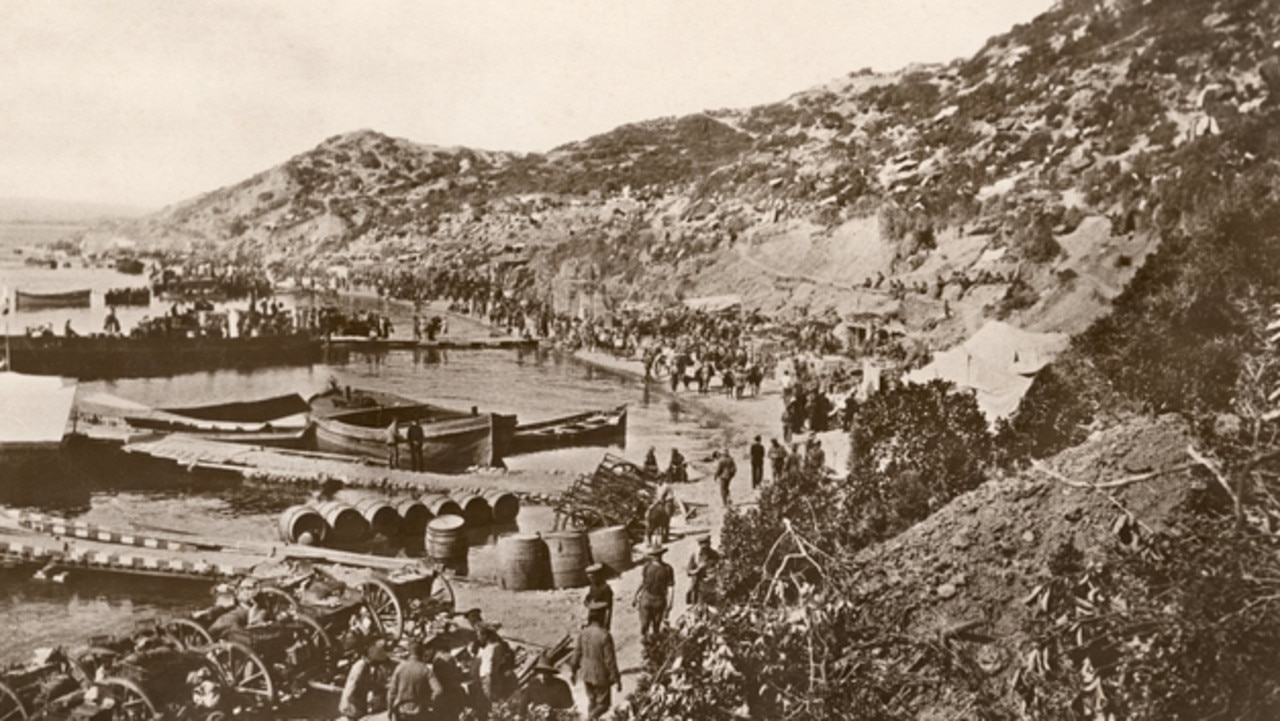F/A-18A Classic Hornet lands at War Memorial’s new Anzac Hall
Known as ‘the Ferrari of the skies’, a classic Hornet has been gently craned into the War Memorial’s new Anzac Hall expansion, which will honour Australia’s recent overseas missions

READING LEVEL: GREEN
It had a top speed of almost 2000km/hr, but an iconic* Australian military jet travelled at a snail’s pace this week as it was carefully lifted off the back of a semi-trailer.
Described as the “Ferrari of the skies”, the F/A-18A Classic Hornet touched down at the Australian War Memorial on Tuesday, where it will soon feature as part of a spectacular $500 million redevelopment.
The Daily Telegraph was there in Canberra as the ferocious aircraft, weighing almost 17,000kg, was carefully manoeuvred* into its final resting home, Anzac Hall, which will open to the public next year.
Watching on was former RAAF* Pilot Group Captain Michael “Cletus” Grant, whose name will be etched in history, forever printed on the Classic Hornet’s side.
Group Captain Grant flew with the famous No. 75 Squadron, which conducted hundreds of combat missions and dropped laser-guided bombs during the 2003 invasion of Iraq. They would return to the Middle East to combat Islamic State in 2016-2017.

“This aeroplane … you would ask a lot of it … and it would just keep giving. It was fabulous,” he said.
“This was the Ferrari of the skies for us. If you treated it well and flew it smoothly, it would reward you.”
Group Captain Grant’s missions in Iraq would sometimes involve more than 10 hours of flying. He was harnessed in a single-person cockpit surrounded by pages of maps – vital in the days before digital navigation.
In the dark, he carried an extra 8kg wearing a pair of night-vision goggles.
“The fact that a Classic Hornet is going in (to the War Memorial) is a great representation of not just the aircrew … but the maintainers*, the logistics* staff, the administration … the Air Force family,” he said.
The Classic Hornet’s arrival marks the largest relocation* of military technology in War Memorial history. A C-130 Hercules cargo aircraft and a Bushmaster were also moved in this week.

Anzac Hall is expected to open to the public early next year. The redevelopment will feature two levels and 6,500 sqm of gallery space.
Group Captain Grant, who received a Distinguished Service Medal, has also decided to donate some of his uniforms and combat equipment.
No. 75 Squadron, formed with a magpie on their crest and the motto “seek and strike”, were first deployed to New Guinea in 1942.
“I think the magpies would be very proud of this,” Group Captain Grant said.
Senior Curator Dr Kerry Neale said the expansion presented an “exciting opportunity to tell more of Australia’s experiences of war, particularly conflicts in the Middle East”.
Memorial Director Matt Anderson added: “It is allowing us to tell the story of Afghanistan, Iraq and 63 peacekeeping missions*, creating a space for the contemporary veteran*.”

ANZAC DAY PAST AND PRESENT
The Australian War Memorial website states the lower galleries of Anzac Hall will focus on more recent conflicts, highlighting Australia’s involvement in peacekeeping operations as well as Australia’s commitments to the Middle East and Afghanistan.
While Anzac Day on April 25 was initially commemorated in 1916 to remember those lost at Anzac Cove during WWI, Australian servicemen and women have since fought in more than eight wars and contributed to peacekeeping efforts all over the world every year since 1947, according to the Department of Veterans Affairs’ Anzac portal.

WAR AND PEACE ABROAD
Australia largely has a reputation as being a peaceful country, not often prone to conflict or threat of invasion. Despite this, we have been involved in several conflicts and peacekeeping efforts across the globe. Here are some notable statistics from the Australian War Memorial.
* Since 1947, Australia has taken part in more than 60 international peacekeeping missions in more than 30 countries and disputed zones*
* A total of 103,044 people have died as a result of service with Australian units since the Sudan conflict of 1885
* WWI led to the most deaths of all the wars that Australia has been involved in, with 61,678 Australians losing their lives in the Great War
* Lasting 19 years, the war in Afghanistan was the longest war Australia was involved in. About 26,000 Australian Defence Force personnel served in the conflict and 42 lost their lives
POLL
GLOSSARY
- iconic: symbolic of a time, place or culture
- manoeuvred: carefully moved into place with great skill
- RAAF: Royal Australian Air Force
- maintainers: people who maintain, service and repair the aircraft
- logistics: people who plan and co-ordinate the movement of people, equipment and supplies and enable the RAAF to carry out missions
- relocation: moving equipment from one place to another
- peacekeeping missions: following conflicts and during times of treaty, sometimes opposing sides request or agree for peacekeepers to be sent to the area to make sure that the conditions of peace are maintained. Australian defence personnel have been sent to more than 60 peacekeeping missions since 1947
- contemporary veteran: present day veteran, or former defence force personnel
- disputed zones: a region or territory where there is a conflict over who controls or rules over it
EXTRA READING
School revokes Anzac Day opt out
Why we mark Anzac Day each year
Anzac diary sheds new light on WWI
QUICK QUIZ
1. How fast can the Classic Hornet fly?
2. What is the name of the new section at the War Memorial where the Hornet will be housed?
3. Which squadron did Group Captain Grant fly with?
4. How many peacekeeping missions has Australia taken part in?
5. How long did the Afghanistan war last?
LISTEN TO THIS STORY
CLASSROOM ACTIVITIES
1. Focus on Anzac Day traditions
Further develop your understanding of Anzac Day by researching what commonly happens at an Anzac Day ceremony and about other traditions of the day. Write a paragraph each to explain three special things that one might expect to observe on Anzac Day. Then draw a picture of an Anzac Day ceremony, showing some of these traditional features.
Time: allow 30 minutes to complete this activity
Curriculum Links: English; History
2. Extension
Anzac Day is important to Australians. Write down how you would explain Anzac Day to an overseas visitor who may not know its significance.
Time: allow 15 minutes to complete this activity
Curriculum Links: English; History
VCOP ACTIVITY
Vocabulary recycle
There is some vivid vocabulary being used in the article, and I am not just talking about the glossary words. Go through the article and highlight the high-level language that you are impressed by in yellow.
See if you can borrow two of these wow words to reuse in your own way.
Remember vocabulary is a great way to connect with the audience, but you need to think about who your audience is so you make great word choices.
Who will the audience be in your recycled sentences?

